Kobe beef vs wagyu a5 – what’s the difference?

Tsukemen vs Miso ramen – what’s the difference?
October 3, 2024
The best 15 chinese food near me in KL
October 4, 2024Kobe beef vs wagyu a5 – what’s the difference?
In the world of premium beef, two names often stand out: Kobe beef and Wagyu A5. These luxurious meats are celebrated for their incredible marbling, tenderness, and rich flavor. However, many people confuse the two, thinking they are the same. While Kobe beef is a type of Wagyu, not all Wagyu is Kobe beef.
In this blog, we’ll dive into the key differences between Kobe beef and Wagyu A5, exploring their origins, grading system, and what sets them apart in terms of taste and quality. If you’re curious about what makes these beef varieties so special, keep reading!
What is kobe beef?
Kobe beef is a high-quality beef from the Tajima strain of Japanese Black cattle, raised in the Hyogo Prefecture of Japan, particularly around the city of Kobe. It is renowned for its exceptional marbling, tenderness, and rich flavor, making it one of the most sought-after and expensive meats in the world.
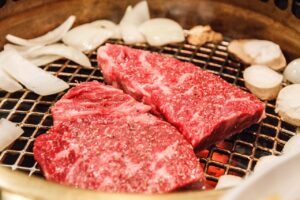
History of kobe beef
Origins
- Ancient Roots:
- The origins of Kobe beef can be traced back over 1,000 years to the Heian period (794-1185), when cattle were introduced to Japan from China and Korea. These early cattle were primarily used as draft animals for agricultural purposes rather than for meat production.
- Tajima Cattle:
- In the 16th century, the Tajima breed of cattle was developed in the Hyogo Prefecture. The unique environment and climate of this region, combined with selective breeding, contributed to the development of cattle that would eventually be known for their exceptional meat quality.
Development of Kobe Beef
- Kobe’s Role:
- The city of Kobe, located in Hyogo Prefecture, became a central hub for trade and agriculture during the Edo period (1603-1868). The region’s cattle were raised and sold in the city, leading to the association of high-quality beef with the name Kobe.
- Western Influence:
- The opening of Japan to the West in the late 19th century brought significant changes to Japanese cuisine. The introduction of Western culinary practices led to a greater appreciation for beef, especially in urban centers like Kobe.
- During this period, the consumption of beef became more popular among the Japanese, and restaurants specializing in Western-style dishes began to emerge.
- Formal Recognition:
- In the early 20th century, the quality of Tajima cattle gained formal recognition. In 1914, the Hyogo Prefecture established a grading system for beef, helping to distinguish high-quality meat from lesser grades.
- The Kobe Beef Marketing and Distribution Promotion Association was formed in 1983 to protect and promote genuine Kobe beef, ensuring strict adherence to quality standards.
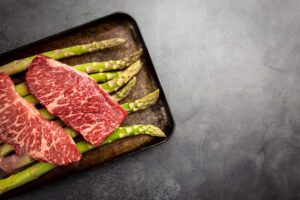
Global Fame
- International Recognition:
- In the 1980s and 1990s, Kobe beef gained international fame, particularly in the United States and Europe. Its unique flavor and texture caught the attention of chefs and food enthusiasts, leading to a surge in demand for this luxury product.
- The term “Kobe beef” began to be used more widely, but this also led to instances of mislabeling, with many restaurants and retailers using the term to describe various types of beef not produced in accordance with Kobe standards.
- Regulation and Protection:
- To combat mislabeling and protect the reputation of Kobe beef, the Japanese government has implemented strict regulations regarding its production. Authentic Kobe beef must come from purebred Tajima cattle that are born, raised, and slaughtered in Hyogo Prefecture.
- In 2014, Kobe beef received geographical indication (GI) status, similar to how Champagne and Parmesan are protected. This designation helps ensure that only beef meeting specific criteria can be labeled as Kobe beef.
Modern Day
- Culinary Status:
- Today, Kobe beef is regarded as one of the most luxurious and expensive meats in the world. It is celebrated for its exceptional marbling, tenderness, and rich flavor, making it a sought-after delicacy in high-end restaurants globally.
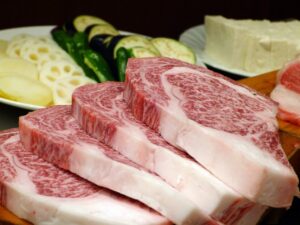
What is wagyu beef ?
Wagyu beef comes from specific Japanese cattle breeds known for their exceptional marbling, tenderness, and rich flavor. The term “Wagyu” literally means “Japanese cow.” These cows are raised with meticulous care, often on a diet that includes grains, and they are known for their calm demeanor, which contributes to the quality of the meat.
Wagyu beef is renowned for its high levels of intramuscular fat, giving it a buttery texture and melt-in-your-mouth quality. It’s often graded based on its marbling, color, and overall quality, with the highest grades being highly sought after by chefs and food enthusiasts around the world. Enjoyed in various forms—from steaks to sushi—Wagyu offers a luxurious dining experience that celebrates its rich heritage.
History of wagyu beef
Origins
- Ancient Japan: The domestication of cattle in Japan began around the 2nd century. These cattle were primarily used for agricultural work, such as plowing fields.
19th Century Developments
- Meiji Era (1868-1912): As Japan modernized, the government began importing Western cattle breeds to improve the native stock. This crossbreeding led to the development of several unique breeds, including the four main types of Wagyu: Japanese Black, Japanese Brown, Japanese Shorthorn, and Japanese Polled.
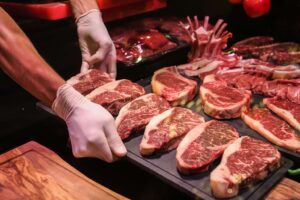
20th Century
- Quality Focus: After World War II, Japan shifted focus to breeding high-quality cattle. Farmers began to prioritize marbling, leading to the distinct characteristics of Wagyu beef we know today.
- Culinary Recognition: By the 1980s, Wagyu gained recognition both domestically and internationally for its unparalleled flavor and texture.
Global Fame
- International Interest: In the 1990s, Wagyu beef began to be exported outside Japan, particularly to the United States and Australia, where it is now raised using similar breeding practices.
- Certification and Grades: The Japanese government established strict guidelines for grading Wagyu, ensuring that only the highest quality beef meets the standards. This includes the famous A5 grade, which signifies exceptional marbling and tenderness.
Modern Day
Wagyu beef is celebrated worldwide, known for its luxurious qualities and often featured in gourmet restaurants. It represents a blend of traditional Japanese farming methods and modern culinary appreciation, making it a prized delicacy for food lovers everywhere.
What’s the difference between kobe beef vs wagyu?
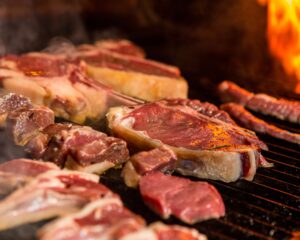
Wagyu
- Definition: Wagyu refers to a specific breed of cattle from Japan, which includes several strains. The name “Wagyu” translates to “Japanese cow.”
- Types: There are four main types of Wagyu: Japanese Black, Japanese Brown, Japanese Shorthorn, and Japanese Polled. Japanese Black is the most common and is known for its exceptional marbling.
- Global Breeding: Wagyu is now raised in various countries, including the U.S. and Australia, often with a focus on producing high-quality beef.
Kobe Beef
- Definition: Kobe beef is a specific type of Wagyu beef that comes from the Tajima strain of Japanese Black cattle, raised in the Hyogo Prefecture, with Kobe being its capital.
- Strict Regulations: To be labeled as Kobe beef, the meat must meet stringent criteria, including being from a specific lineage, raised in a designated area, and achieving a certain quality grade (usually A4 or A5).
- Limited Supply: Kobe beef is rare and highly sought after, which adds to its exclusivity and premium price.
Summary
In the realm of high-end beef, two renowned varieties frequently garner attention: Kobe beef and Wagyu A5. These exquisite meats are prized for their exceptional marbling, tenderness, and deep flavor. Despite their similarities, many people mistakenly believe they are identical. While Kobe beef is indeed a specific type of Wagyu, not all Wagyu qualifies as Kobe beef.



